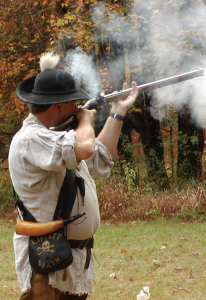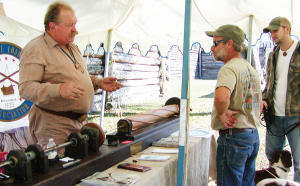by James C. Fulmer | NMLRA Past President
The last major lead ore smelter that is left in the United States will probably be closed by the time you read this article. The Doe Run plant in Herculaneum, MO, was the last primary lead smelter in the country.
The facility used raw ore mined from local deposits. This closure will affect the price of lead, since the lead ore that was mined in Viburnum, MO, was smelted at the Doe Run facility.
The smelter existed in the same location for 121 years and was the only one of its kind left. Other smaller, secondary smelters still exist in this country, but they can only extract lead from used items that were made of lead such as reclaimed bullets, shot, car batteries, and other recyclable products made of lead.
For the last 25 years the Doe Run facility has been struggling to meet the Environmental Protection Agency’s strict new air standards. The Missouri Department of Natural Resources issued a cease and desist order. Doe Run cleaned up the facility in 2002 and was able to meet the Clean Air Act lead standard. It was not long before the EPA added new standards and restrictions.
In 2010, Doe Run announced that it would not modify the plant to the new restrictions (which would cost in the neighborhood of $100 million), but instead would be shutting down.
The National Rifle Association’s Institute for Legislative Action stated in a press release that “What is clear is that after the Herculaneum smelter closes in December, entirely domestic manufacture of conventional ammunition, from raw ore to finished cartridge, will be impossible..
China was, and still is, the number one lead producer, followed by Australia, and then it was the US, until December. Missouri’s lead belt was the source of lead since the 1700s, but it wasn’t always that way.
In the spring of 1778, after depleting most sources of lead for making musket balls and rifle balls for the American Revolution, there was a serious shortage of lead in this country. The French were coming to our aid after the Continental Army’s victory at Saratoga in 1777, but until supplies arrived, there was dire need for lead. Most of the lead that did find its way into the hands of the Continental Army and state militias was from France, but many states, including Connecticut, Illinois, Mississippi, Virginia, and Pennsylvania, smelted lead ore and shipped it to the front as lead ingots to be cast into ammunition.
This year on Oct. 11-12, an event took place that was like no other at Fort Roberdeau—the “the Lead Mine Fort”—near Altoona, PA. Fort Roberdeau was built in the spring of 1778 to protect the lead mines in the Sinking Valley area of Pennsylvania.
Here patriots labored to mine the lead, then smelt it, and ship it to the Continental Army to be used during the war.
The “Lead Fort” only existed a few years in history, fell into ruins, and eventually disappeared. In 1976 it was reconstructed as a Blair County Bicentennial project. The reconstructed fort, on its original site, is located on 230 acres and is adjacent to the Altoona Rifle and Pistol Club. What more perfect place for an 18th Century Marketfaire and Rifle Frolic than on this historic site? That is what Roland Cadle and Pam Roub of Village Restorations thought and contacted the NMLRA in the spring of 2013 about hosting the event.
Village Restorations put on the Colonial Marketfaire at Fort Roberdeau and the NMLRA, with the help of Getz Barrel Co., put on the shooting portion of the event at the Altoona Rifle and Pistol Club’s facility. The NMLRA handled the main range and worked with the public by introducing them to muzzleloading firearms, while Getz Barrel Company handled the pre-1780 primitive Woodswalks, in keeping with the “spirit” of the Fort.
What a terrific event! Thursday, Oct.
10, people started to arrive and an NMLRA Range Officer course was given to all who wanted to become certified range officers. This was followed up by a feast of lobster, clam, corn on the cob, baked potato and onions steamed in seaweed, made by Ruth Waugh and Glen Dickey from Maine. It went so well, that the Thursday night, first-time lobster feast might become an annual event! Then it started to rain. It rained hard through the night on Thursday.
Everybody I talked to commented that every time the rain woke them up, it was raining harder. Friday shooting was tough because of the rain, but the main firing line had some cover so you were able to load under cover and then go into the rain to shoot. The primitive side of the shoot was shut down for the day. It gave time for everybody to go to the Marketfaire and many vendors said it was the best rainy day sales they had this year. Friday evening we had a “Come Meet Your Neighbors” program at the Altoona Rifle and Pistol Club. The guest speaker was Corey Brossman , the TV show host of Innerloc’s Out- There. Corey can be seen on the Sportsman Channel with many great adventures with the bow and muzzleloader. There were light refreshments and door prizes. Everybody was happy to be dry and warm in the clubhouse that evening.
Saturday, we awoke to a clear blue sky; it was an absolutely beautiful fall day. The shooting started early and went all day. The primitive side held two Woodswalks—one smoothbore and one flintlock rifle, both with 22 shots, which kept people busy. The main range had 27 matches with a novelty range, the “Iron Valley,.
where you shot a match and warmed up for the Woodswalks. There were ten aggregates on the main firing line. By order of popularity, they were: offhand rifle; pistol; one-gun; smoothbore; ladies; light chunk gun under 14 pounds; in-line, and unlimited chunk gun over 14 pounds. The main line shooters picked their prizes off a common table by the way the aggregates finished in popularity, so offhand got first pick. Harry Keppler chose a smoothbore swamped barrel made by Ed Rayl. Pistol was also won by Harry Keppler; one-gun was won by Rick Blizard; smoothbore was won by Brook Aldrich; ladies was won by Carol Aldrich; light chunk was won by Mike Wengert; in-line was won by Corey Brossman, and un-limited chunk was won by David Comer.
The winners of the Flintlock Rifle Woodswalk were: First place, Mark Pushkis, who won a powder horn made by John Dewald, Jr. and a custom medallion made by Dave Hughes. Second place: Jeff Tebay won a Getz swamped rifle barrel; and Third place winner, Mike Ripley, won a bark tan medicine bag made by Lally House. Brook Aldrich won the smoothbore Woodswalk and took home a shooting bag made by Scott Bryan and a Dave Hughes medallion.
I can’t thank everybody enough who made this shoot a success—from the shooters themselves, who braved the weather, to all the range officers and officials.
Wally Hart and Bob Slusser ran the NMLRA’s rifling machine at Fort Roberdeau through the rain, and Don Blazier, who filled in anywhere I needed him; Mike Wengert for scoring, to Ruth Waugh and Linda Blizard for registering and keeping me straight handing out prizes. Also thanks to all the people who helped the public take their first shots with a muzzleloader including Wes Greist and Curt Fulmer.
A special thanks once again to Roland Cadle and Pam Roub; they are the ones who dreamed up the event and kept pushing all of us to the finish. I’m hoping this will become an annual event, held at the same place, just keep watching for upcoming dates.




